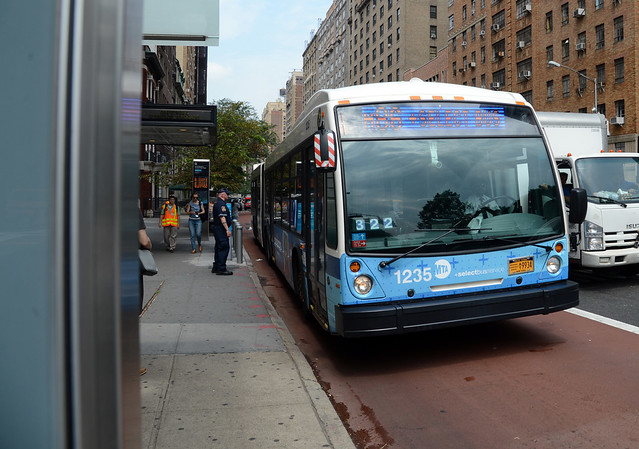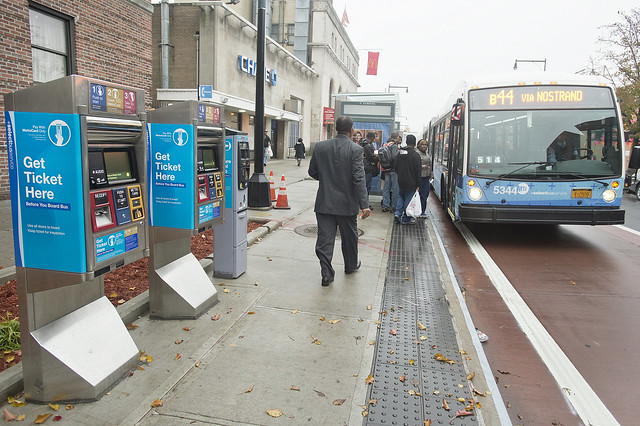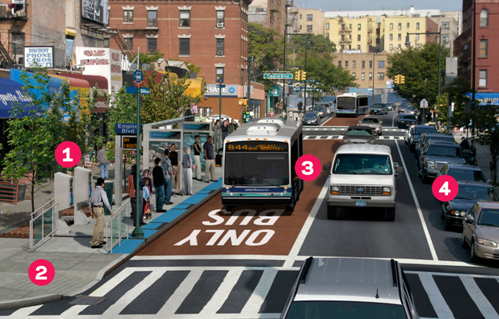
NYC Transit may put a pause on rolling out Select Bus Service routes for the next few years. (Photo by flickr user Stephen Rees)
With so many moving financial parts these day, it can be tough to keep track of where the MTA stands fiscally. Gov. Andrew Cuomo’s state of emergency declaration regarding the subways and his subsequent Subway Action Plan, largely ineffectual so far, has allowed the MTA to bypass traditional procurement channels while adding nearly $1 billion to its expense ledger. Meanwhile, relying on the promise of a strong economy and steady fare revenue, the MTA’s out-year financial projections remain as tenuous as ever, and it seems that some cuts may be on the table.
The story took a few weeks to develop after the MTA released its July Financial Plan last month largely because the cuts are buried throughout, but it broke last week in an article in The Wall Street Journal noting that cost reductions required, in part, to find money for the Subway Action Plan may lead to bus and subway service cuts. Most notably, the MTA may be pausing rollout of Select Bus Service routes for at least four years. Here’s how Paul Berger reported it:
The Metropolitan Transportation Authority plans to stop expanding a bus rapid-transit service, reduce bus fare-evasion patrols and cut dozens of positions for subway car cleaning as it seeks $562 million in cost reductions during the next few years.
According to emails reviewed by The Wall Street Journal, some MTA board members are concerned that the authority is taking such cost-savings measures even as it hires more than 1,000 workers under a plan launched last year to improve subway service, known as the Subway Action Plan.
MTA board member Carl Weisbrod, an appointee of Mayor Bill de Blasio, wrote in an Aug. 5 email to fellow board members and senior MTA officials: “It’s hard to escape the conclusion that we’ve giveth with one hand through the Subway Action Plan, and we’ve taketh away, to some extent, through these service cuts.”
In response, MTA Chairman Joe Lhota called the shifting funds a “redeployment of resources,” but a cut is a cut by any name. By holding back on Select Bus Service routes, other than those currently being planned and those needed on 14th Street for bus capacity during the L train shutdown, the MTA saves $28 million, a drop in the $500 million bucket the agency is trying to cobble together. It seems like a Pyrrhic victory as Select Bus Service routes are among the best in the city with touches of a modern bus system, including pre-boarding fare payment and dedicated lanes. So why cut them?
The answer is not quite as black-and-white as it seems, and the MTA may not be cutting off its nose to spite its face. In my view, it takes far too long for the MTA and New York City to roll out Select Bus Service routes. There are far too many hyper-local considerations given far too much weight while the needs of the riders are often backburned by trumped-up concerns over parking spots. We’ve seen this play out again and again and again. So a four-year pause may impact only a handful of routes.
But that’s a bad reason to accept the pause. The better reason is embedded in the MTA’s 500+ breakdown of the financial plan [pdf]. Led by Andy Byford, New York City Transit is currently amidst an analysis and reassessment of the entire citywide bus network. This includes every route, every stop and every 20th century element of the bus network including the boarding process. By 2021, Transit expects to amidst a major rollout of a new fare payment system, and the agency will have completed its review of the bus network. It doesn’t make sense to spend political capital and dollars on rolling out Select Bus Service routes now that may not fit in with the redesigned bus network, and that’s a good enough, but not great, reason to pause so long as the MTA commits to resuming introducing proper SBS (or even real BRT) routes to NYC once the bus turnaround plan is unveiled.
The wild card here though is city politics. Since buses uses city streets, NYC DOT is essentially in charge of permitted Select Bus Service routes, and SBS has become one of the few tools the city has to control its own transportation infrastructure. (Whether the mayor has used this tool efficiently or effectively or frequently enough is open for debate, though I’m sure you know my thoughts.) By pausing SBS rollout and by not informing the city or even working with them to cushion this announcement, the MTA has put itself at odds with the city agency that can by a major ally in pushing forward on the eventual bus turnaround plan. This strikes me as bad city-state politics and a move that could be quite costly down the road.
So ultimately, I think this was a case of bad presentation and mixed messages in a 500-page financial document. The MTA shouldn’t penny-pinch the only good approach to new bus routes over a matter of $28 million spread out over four years, but the agency shouldn’t be introducing new bus routes until it has a handle on how to improve bus service overall on a citywide basis. It’s OK, but not great, to halt Select Bus Service rollout so long as it comes back with a vengeance when the Bus Tunraround plan is unveiled. And if there’s no Bus Turnaround plan, well, that’s a different issue entirely.



 NYC DOT/MTA)” width=”575″ height=”362″ class=”size-full wp-image-15421″ /> NYC DOT and city officials have called the Woodhaven/Cross Bay Boulevard SBS plans ambitious, but there’s much to learn from the hype. (Source: NYC DOT/MTA)
NYC DOT/MTA)” width=”575″ height=”362″ class=”size-full wp-image-15421″ /> NYC DOT and city officials have called the Woodhaven/Cross Bay Boulevard SBS plans ambitious, but there’s much to learn from the hype. (Source: NYC DOT/MTA)

